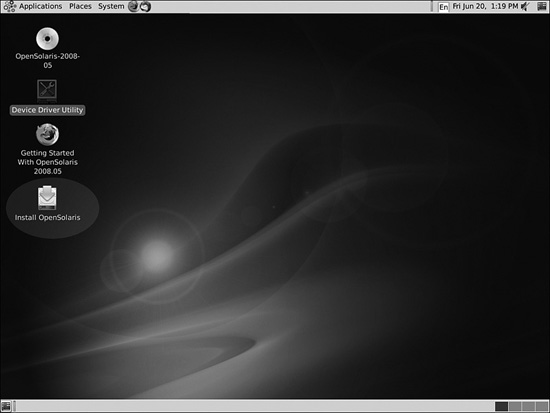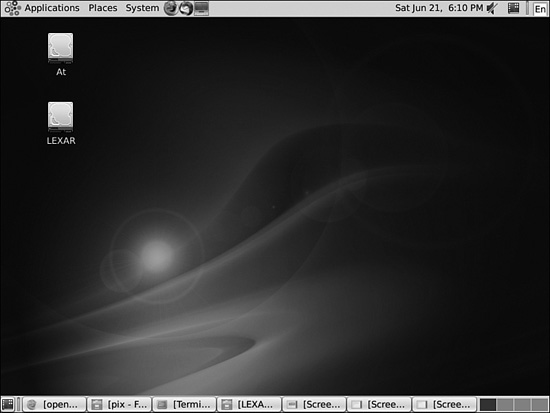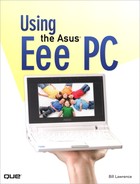Chapter 13
Loading OpenSolaris
IN THIS CHAPTER
![]() Install Open Solaris on the Eee PC
Install Open Solaris on the Eee PC
Open Solaris is the Sun Microsystems version of the UNIX. While Linux is very similar to UNIX, they aren’t the same. If you ever wanted to learn about UNIX or you just happen to be a UNIX user, OpenSolaris is a great choice for the Eee PC operating system. It comes with OpenOffice and has enough applications to be useful for general computing.
When I first thought about this chapter, I imagined that I would write about loading Mac OS on the Eee PC, and thus began researching what would be required to run Leopard on the Eee PC. However, as luck would have it, OpenSolaris became available at just the right time. Unlike OS X Leopard, there are no licensing infringement issues involved in running OpenSolaris on the Eee PC. Also, Sun Microsystems and the OpenSolaris community have taken an interest in the Eee PC, so you’ll find blogs and web sites devoted to this. Moreover, drivers and workarounds are freely available. OpenSolaris has a pretty big community to support this sort of stuff, with more than 60,000 registered members.
For those unfamiliar with Solaris in general, it’s Sun Microsystems’ version of UNIX (derived from UNIX V). Solaris is a very powerful, mature operating system. OpenSolaris is an open source version of Solaris that’s packed with lots of built-in goodies, such as a graphical package manager. In fact, I’m writing this chapter using OpenOffice while running my Eee PC under OpenSolaris, and I used the OpenSolaris screenshot tool to take the screenshots of the desktop for this chapter.
Challenges to Running OpenSolaris on the Eee PC
Running OpenSolaris on the Eee PC does pose some challenges that you should be aware of before you decide whether to embark on installing it:
![]() Open Solaris does not have the driver for the Atheros wireless built into the Eee PC. However, you can easily download and install it, as described in the “Fixing the Wireless Issue” section later in the chapter. This does mean that you’ll either have to download it first or have access to another computer.
Open Solaris does not have the driver for the Atheros wireless built into the Eee PC. However, you can easily download and install it, as described in the “Fixing the Wireless Issue” section later in the chapter. This does mean that you’ll either have to download it first or have access to another computer.
![]() The internal keyboard does not work on some Eee PC models (such as my 701 4G) unless you unload and reload the keyboard driver module. You can’t do this until you’ve installed OpenSolaris, which makes trying to install OpenSolaris rather daunting. The workaround is to plug in a USB keyboard for the installation, after which you can then modify some startup files to unload and reload the keyboard driver module, as described in the “Fixing the Keyboard Issue” section later in this chapter.
The internal keyboard does not work on some Eee PC models (such as my 701 4G) unless you unload and reload the keyboard driver module. You can’t do this until you’ve installed OpenSolaris, which makes trying to install OpenSolaris rather daunting. The workaround is to plug in a USB keyboard for the installation, after which you can then modify some startup files to unload and reload the keyboard driver module, as described in the “Fixing the Keyboard Issue” section later in this chapter.
![]() The Eee PC sound hardware isn’t supported by OpenSolaris. However, you can get it to work by using the latest Open Sound System driver. I don’t recommend doing that just yet as it isn’t stable, so I don’t cover it in this chapter. By the time you read this, things may be a bit more stable. It works, but folks are reporting high CPU load from Open Sound System (and on the Eee PC, that’s a bad thing). Check http://www.4front-tech.com/download.cgi for OpenSolaris versions.
The Eee PC sound hardware isn’t supported by OpenSolaris. However, you can get it to work by using the latest Open Sound System driver. I don’t recommend doing that just yet as it isn’t stable, so I don’t cover it in this chapter. By the time you read this, things may be a bit more stable. It works, but folks are reporting high CPU load from Open Sound System (and on the Eee PC, that’s a bad thing). Check http://www.4front-tech.com/download.cgi for OpenSolaris versions.
![]() Suspend/resume doesn’t work (yet). So, you won’t be able to save your battery during slack times by suspending operation.
Suspend/resume doesn’t work (yet). So, you won’t be able to save your battery during slack times by suspending operation.
Downloading and Installing OpenSolaris
Note that after OpenSolaris 2008.05 is loaded on a 4GB Eee PC, you have about 630MB of free space on the solid-state drive. That’s not a lot of space compared to the Linux operating systems, so you’ll need to by very choosy about what applications you’ll install. Also, you’ll really want an MMC-SD flash memory card for additional storage. Like some of the Linux operating systems, OpenSolaris is available as a Live CD. This means that after you write the ISO file for OpenSolaris to a CD, you load and run the operating system from the CD before actually installing it. This gives you a chance to give OpenSolaris a try before committing to installation and, if you don’t like OpenSolaris, your Xandros installation remains intact.
You’ll need the following to install OpenSolaris on the Eee PC:
![]() A USB CD drive
A USB CD drive
![]() A USB keyboard (for some Eee PC models)
A USB keyboard (for some Eee PC models)
![]() A USB flash drive (for the drivers)
A USB flash drive (for the drivers)
You can download OpenSolaris from http://www.opensolaris.org/index.html. This is a sizable download, over 685MB, so it’ll take a while. It’s an ISO file, so you need to burn this to a CD before installing. This is also a Live CD, so it will actually boot into OpenSolaris before the installation. (This is where the USB keyboard comes into play for some models, because, until you’ve loaded OpenSolaris and fixed the problem, the Eee PC’s keyboard won’t work.)
If you are downloading the ISO file using Xandros, you’ll want something like K3b (which is covered in Chapter 9, “Must-Have Utilities”). On Windows machines, you can use applications such as Nero to “burn” the CD.
Before you begin, back up any information that you have on your Eee PC. The installation will overwrite everything on the solid-state drive.
When you’re ready to install, make sure the USB keyboard is plugged in and then load the CD into the drive. By the way, the installation will go much faster if you make sure that you don’t have an MMC-SD card in the slot. Some folks have reported that the installation takes many hours if there is an MMC-SD card in the slot; however, OpenSolaris installed in less than an hour when I did it with an MMC-SD card in the slot.
note
If you want to restore Xandros at any point, see the section, “Restoring Xandros” in Chapter 12.
Start the Eee PC and press F2 when prompted. You’ll want to set the following under Advanced: all devices enabled under Onboard Devices Configuration, and OS Installation set to Start. Tab over to Boot Order and set the CD drive to the top of the list. Press F10, save the changes, and exit. OpenSolaris will load from the CD. After configuring the “Live CD” desktop, you’ll see an Install OpenSolaris icon on the desktop (see Figure 13.1). Double-click the icon to start installing OpenSolaris on the Eee PC.
FIGURE 13.1 The Install OpenSolaris icon.

As you go through the installation process, click Next on each OpenSolaris Installer screen until you reach the Where Should OpenSolaris Be Installed? screen, shown in Figure 13.2. Choose to use the whole disk and then click Next.
FIGURE 13.2 Use the whole disk.

Select the Region, Location, Time Zone, and so forth, and click Next. Select your locale (and language) and then click Next to move on to the Users page. The Users page is a big deal for OpenSolaris. You need to set your username and password. This is one of the two accounts (along with the password for root privileges) you’ll have on the Eee PC. You’ll need that administrative password to do any of the tasks you’d normally do under sudo in the OpenSolaris environment. In this environment, you’ll need to use the su (substitute user) command, and you’ll become the administrative account after you enter the password. When you’ve set this, click Next.
The Installation screen tells you that OpenSolaris will take up 3GB of space; however, it really takes up 3.4GB. Look over everything to make sure it’s correct (if it’s not, click Back to return to the previous screens to fix things). If it’s all okay, click the Install button and go make coffee.
The CD whirs and chugs for about 40 minutes (longer if you didn’t take out your MMC-SD chip) and eventually opens the Installation Is Complete screen, as shown in Figure 13.3. Click Reboot and be patient.
FIGURE 13.3 Time to reboot.

There’s a lot more to load and it’ll take a lot longer than Xandros or Windows does to load. Eventually, you’ll find yourself staring at the lovely, deep blue OpenSolaris wallpaper. Note that this is a GNOME desktop, with the Applications menu in the upper-left corner and four squares in the lower-right corner representing your four virtual desktops (see Figure 13.4).
FIGURE 13.4 Welcome to OpenSolaris.

Fixing the Keyboard and Wireless
Fixing the Keyboard Issue
Fixing the keyboard problem is a fairly trivial matter, though it took me quite a while to track down the problem and the fix on the Internet. You need to unload and then reload the keyboard driver, as follows:
1. Launch a terminal window by choosing Applications, System Tools, Terminal. This opens the Bash shell that you’re familiar with from Xandros. Note the $ prompt. This indicates that you’re logged in as your account, which doesn’t have privileges to change anything outside of your home directories. I’ll use the $ and # (root) prompt conventions in the following examples so that you can keep this straight.
2. Enter the following:
$ su
3. When prompted, enter the administrative password you entered during installation. The prompt should now contain the pound sign (#), which denotes that you’re running as the administrative account.
4. Enter this command:
# modinfo
5. Scroll up until 99 (in the leftmost column) is visible, as shown in Figure 13.5. That should be the number for the following entry:
99 f7fa0000 2a34 101 1 kb8042 (PS/2 Keyboard 1.68, 07/10/18)
FIGURE 13.5 Look for kb8042.

If not, find the entry for kb8042 (PS/2 Keyboard…) and note that number.
6. Press Enter to jump back to your prompt. Enter the following set of commands:
# modunload -i 99
# devfsadm -i kb8042
# modload /kernel/drv/kb8042
Your Eee PC’s internal keyboard should now work. That’s great, but you really want to make this permanent. The basic procedure for this is explained at http://unixsysadmin.net/2008/04/02/solaris-express-on-the-asus-eeepc/, which is the method shown here (with a few modifications):
1. Choose Applications, Accessories, Text Editor and launch a text editor.
2. Use the following for your script (and not what’s on the blog page, which has a typo):
# 1/bin/sh
modunload -i ‘modinfo|awk ‘/kb8042/ {print$1}’
devfsadm -i kb804
modload /kernel/drv/kb8042
3. Save the file as keyfix (it’ll pop into your home directory).
4. Make keyfix a file belonging to the root account and set it to read/write/execute permissions for that user. Enter the following at the administrative prompt:
# chown root keyfix
# chmod u+rwx keyfix
# ls -l
You should see something like the following, showing that the ownership and permissions were successfully changed and that it can now execute:
-rwxr--r-- 1 root staff 105 2008-06-21 18:46 keyfix
5. Copy keyfix to the /etc/init.d/ directory and then link it from the /etc/rc2.d/S99keyfix so that it automatically runs:
# cp keyfix /etc/init.d/
# ln /etc/init.d/keyfix /etc/rc2.d/S99keyfix
Now, when you reboot, you’ll have keyboard support and you’ll be able to use your keyboard.
Fixing the Wireless Issue
Fixing the wireless issue is simple procedure:
1. Download the Atheros driver. Go to http://opensolaris.org/os/community/laptop/wireless/ath/. Scroll down and click the binary package link. The file should be ath-0.7.1-pkg.tar.gz.
2. Plug in the flash drive and wait for the desktop to show the icon for the flash drive.
3. Double-click the icon and navigate to the driver file.
4. Open a second file browser and navigate to your home directory.
5. Double-click the compressed driver file and drag the SUNWatheros file to your the other file browser to place the file in your home directory.
6. From an administrative command prompt, issue this command:
# pkgadd -d ./SUNWatheros SUNWatheros
7. Reboot. When the machine comes up, Solaris will detect your wireless network and prompt you for a security key (if you need one).
Getting OpenOffice.org
You’ll probably want to get OpenOffice.org next. This is a roughly 400MB download, which will eat up a lot of your remaining space. However, there are no other office applications onboard with OpenSolaris, so if you want to have a word processor, illustration package, and so forth, you’ll need to download OpenOffice.org.
note
See Chapter 7 for more details on the OpenOffice.org suite.
Here’s where things get just a little dicey. OpenSolaris has a dandy utility called Package Manager, which is very similar to Synaptic, but running it on the Eee PC kills your keyboard (including your USB keyboard). Also, the package manager is very slow. If you launch it, the “starter” icon comes up…and then it goes away, with nothing to tell you that it’s loading. Wait several minutes and the package manager will appear. Click Reload to update the repository database, and that update is even slower. When it’s done, you’ll find OpenOffice.org under the Office category. Right-click it to select it for downloading and then click Install/Update. After exiting from the package manager, the keyboard will work again.
Summary
OpenSolaris is a powerful, but rather large, operating system to run on the Eee PC. It also taxes the processor a bit. However, most things work pretty well. Under System, Preferences, you’ll find that the display settings work nicely. Also, you’ll find that a lot of the applications you’re looking for, such as GIMP, Firefox, and Thunderbird, are already installed. Sun seems at least somewhat engaged in solving problems for this platform (from the forum and bug entries that already exist). Given that, over time, OpenSolaris on the Eee PC will become even more stable. With the addition of OpenOffice.org, you have pretty much everything you need.
Is it practical? Well, it’s more practical than trying to run Mac OS Leopard. Also, if you’re really a fan of UNIX, it’s great to be able to run it on the Eee PC. Besides, it has a very high “geek coolness” factor. It’s certainly functional, especially if you download OpenOffice.org as well.
